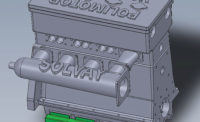The 'Holy Grail' of Diabetes Management
Medical device engineers are working on a wide variety of new products that address the unique needs of diabetics. The “holy grail” is a closed-loop blood glucose monitoring and insulin pump, sometimes referred to as an artificial pancreas, which may be approved for use in the near future.
Glucose levels are normally controlled by hormone insulin, which is released by the pancreas when required. People who have diabetes either do not produce insulin, produce insufficient insulin or the insulin they do produce does not work correctly.
Even with treatments available today, tight blood sugar control remains a challenge and daily struggle for those living with type 1 diabetes. In fact, the majority of diabetics are not achieving recommended target levels.
“An artificial pancreas, essentially a device that would both measure blood sugar and dispense appropriate amounts of insulin to keep levels in optimal range, would take much of the guesswork out of daily management of the disease,” says Dr. Aaron Kowalski, assistant vice president of treatment therapies at the Juvenile Diabetes Research Foundation (JDRF). “In the long-run, controlled blood sugar levels will help to lessen or avert the devastating complications from type 1 diabetes.”
Medical engineers around the world are scrambling to develop an artificial pancreas. There have been several recent breakthroughs in England.
For instance, Joan Taylor, a professor of pharmaceuticals at De Montfort University in Leicester, is developing a device that could be implanted into the body between the lowest rib and the hip and would be topped up with insulin every few weeks. It consists of a metal casing that contains a supply of insulin that is kept in place by a patented gel barrier. The device has no moving parts or batteries and would be implanted internally, making it invisible on the outside.
When glucose levels in the body rise, the gel barrier starts to liquefy and lets insulin out. The insulin feeds into the veins around the gut and then into the vein to the liver, mimicking the normal process for a person with a healthy pancreas. As the insulin lowers the glucose level in the body, the gel reacts by hardening again and stopping the supply.
“This means the right amount of insulin is released automatically every time the body needs it, putting an end to daily injections and the guesswork often involved for diabetics when trying to control blood glucose levels,” says Taylor. “By controlling blood glucose so effectively, we should be able to help reduce related health problems, [such as heart disease, kidney disease, strokes and blindness].” If current trials prove successful, Taylor claims the device could be available in five to 10 years.
In the meantime, most people who suffer from type 1 diabetes must still rely on pricking their finger and testing their blood several times a day. Engineers at Imperial College London want to give that job to a microchip. They have developed a special blood glucose control chip that reacts to changes in sugar levels just like cells in the human body.
The “silicon pancreas” mimics the insulin controlling beta cells, as well as the glucagon controlling alpha cells, normally found in a healthy organ. In diabetics, beta cells are destroyed by the body’s immune system and alpha cells tend to suffer over the long term.
“When paired with a continuous glucose monitor, and a pair of insulin and glucagon pumps, the silicon pancreas should be able to give diabetics an approximate response to blood sugar levels close to what their bodies would normally produce,” says Chris Toumazou, a professor in the Department of Electrical and Electronic Engineering.
“Alpha cells and beta cells in the pancreas respond differently to blood sugar levels,” adds Toumazou. “When glucose is high, beta cells are stimulated to release insulin in large spikes that can be plateaued as needed. After a spike, beta cells tend to remain silent for longer periods of time. Alpha cells, in contrast, release glucagon when blood sugar levels are low, and they do so in rapid bursts. The frequency of these bursts changes as glucose levels rise and fall.”
The silicon pancreas has two sets of control algorithms built into it that copy these types of alpha and beta cell responses. When the virtual cells are triggered via the blood sugar monitor readings, the chip activates the appropriate insulin or glucagon pump in the same way that the real cells would release those hormones.
Medical engineers in the United States are also making progress on developing an artificial pancreas. For example, the JDRF has created a device that uses a continuous blood glucose monitor, an insulin and glucagon pump, and a wearable controlling computer to provide patients with the correct hormones in their blood 24 hours a day.
The JDRF’s artificial pancreas project was launched in 2005. Devices have already been successfully tested in controlled inpatient or hospital settings, demonstrating the potential for the technology to improve blood sugar control. The next step is to test the devices in real-world conditions.
“Clear and reasonable regulatory guidelines must be established to ensure that the upcoming studies advance the technology to reach patients as soon as possible,” says Jeffrey Brewer, JDRF’s president and CEO. “We believe a safe and effective first-generation artificial pancreas system is possible with today’s technology, even as we continue to encourage development of improved devices.”

